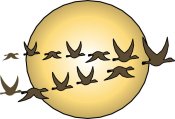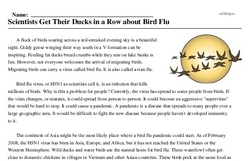Scientists Get Their Ducks in a Row about Bird Flu
A flock of birds soaring across a red-streaked evening sky is a beautiful sight. Giddy geese winging their way south in a V formation can be inspiring. Feeding fat ducks bread crumbs while they rest on lake banks is fun. However, not everyone welcomes the arrival of migrating birds. Migrating birds can carry a virus called bird flu. It is also called avian flu.
Bird flu virus, or H5N1 as scientists call it, is an infection that kills millions of birds. Why is this a problem for people? Currently, the virus has spread to some people from birds. If the virus changes, or mutates, it could spread from person to person. It could become an aggressive "supervirus" that would be hard to stop. It could cause a pandemic. A pandemic is a disease that spreads to many people over a large geographic area. It would be difficult to fight the new disease because people haven't developed immunity to it.
The continent of Asia might be the most likely place where a bird flu pandemic could start. As of February 2008, the H5N1 virus has been in Asia, Europe, and Africa, but it has not reached the United States or the Western Hemisphere. Wild ducks and water birds are the natural hosts for bird flu. These waterfowl often get close to domestic chickens in villages in Vietnam and other Asian countries. These birds peck at the same food as chickens in the wet rice paddies. Then, the chickens, which live close to people, could pass the disease to humans. This is how people contracted the first cases of bird flu, and scientists are trying hard to track and understand the disease.




